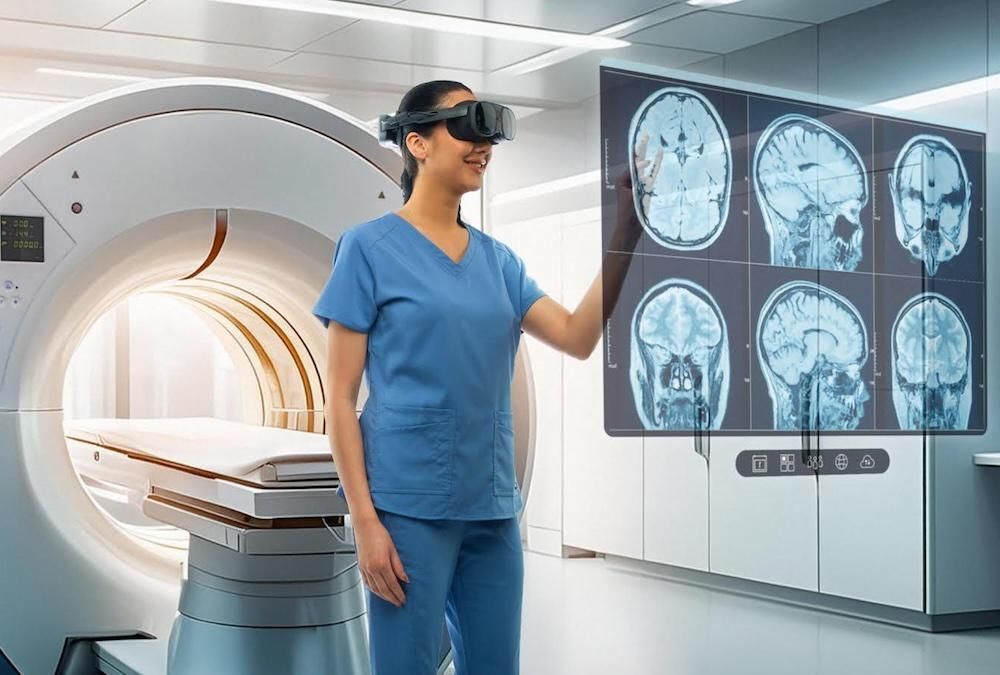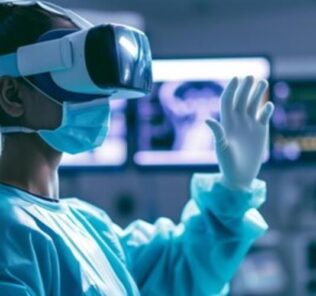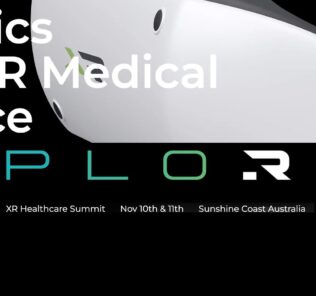HTC VIVE Shares Tips and Tricks for Deploying VR in Hospital Settings
Virtual Reality (VR) and Extended Reality (XR) technologies have surged in popularity, promising immersive experiences and transformative applications across healthcare professions. Children’s Hospital of Philadelphia (CHOP) has embarked on a journey to integrate VR / XR into medical practices to enhance patient care, education, and overall hospital experience. This HealthySimulation.com will explore CHOP’s challenges, considerations, and successes into the integration of VR / XR into initial onboarding and annual training of healthcare professionals, before the upcoming open-access webinar April 24th at 9AM PT / 12PM ET Navigating Deployment of XR / VR at Children’s Hospital of Philadelphia.
Call for Action to Adopt VR / VR In Situ
From the outset, the adoption of VR / XR required more than just enthusiasm for the latest technology trends. VR / XR integration demands a meticulous evaluation of use cases versus buzzwords, to ensure every application was appropriate and beneficial. The journey began with the daunting task to determine the hardware and software needs, a process fraught with complexities.
Sponsored Content:
Medical Extended Reality (MXR) Technology within the Children’s Hospital of Philadelphia (CHOP) has been used for numerous endeavors throughout the enterprise over the last decade. Like many healthcare organizations, many teams worked within silos and there was no clear path to start new MXR endeavors. By exploring current MXR use cases within CHOP, starting the CHOP XR workgroup, integrating key stakeholders, and inviting teams to share their barriers along with their successes, CHOP has been able to integrate these projects into their Digital & Technology Services network and deploy sustainable MXR programs.
Keith Widmeier, BA, NRP, FP-C, CHSE and Simulation Immersive Technology Educator of Children’s Hospital of Philadelphia (CHOP) vividly recalls his experiences at home, struggling to enroll VR headsets into the CHOP systems. Throughout his journey, Keith gained insights into navigating connectivity challenges, ensuring accessibility, integration complexities, technology deployment systems, and operational necessities to translate into XR integration within other healthcare systems and higher education institutions on an enterprise level. The traditional methods were inadequate for these advanced devices, highlighting the necessity for innovative solutions. Keith collaborated with CHOPs IT department to navigate through technical barriers, learn and adapt as progress was made. The journey underscored the importance to align technology with practicality and operational feasibility.
Selection of the Right Headset and Software
The selection of the right headset and software is another critical decision point. With a plethora of options that range from mobile-driven to fully immersive VR setups, finding the perfect fit requires careful consideration of our diverse needs and resources. Moreover, ensuring accessibility for all users is paramount, reflecting CHOP’s commitment to inclusivity in a teaching hospital environment.
Sponsored Content:
View the LEARN CE/CME Platform Webinar to learn more!
Space constraints poses yet another challenge, especially in urban settings like downtown Philadelphia. Unlike sprawling landscapes, some facilities demand mobile solutions, prompting creative adaptations in our VR deployment strategies. From surgical prep rooms to critical care units, VR integration experiences wherever possible, can help to prioritize patient comfort and safety.
Accessibility emerged as a recurring theme throughout CHOPs journey, which led to reevaluate traditional workflows and standards. Months refining connectivity protocols to comply with stringent hospital regulations were spent with emphasizes on data security and privacy at every step. While the process was arduous, the end result was a network seamlessly integrated with our VR infrastructure, empowering clinicians and patients alike.
Reflecting on CHOPs journey, future-proofing VR / XR technology remains an elusive goal. The rapid pace of innovation necessitates a proactive approach, to embrace change while acknowledging the inherent uncertainties. However, by focusing on tangible outcomes and sustainable practices, simulationists can navigate this dynamic landscape with confidence and resilience.
The experience at CHOP illustrates the transformative potential of VR / XR in healthcare, tempered by practical considerations and steadfast determination. As the boundaries of innovation continue to be pushed, simulationists must remain grounded in their commitment to accessible, patient-centered care, leveraging technology to enrich lives and advance the frontiers of medicine.
CHOP Incorporates to VR platforms
- SimX: This system is only available on select VR headsets within the Simulation Center. Equipment must be reserved through the Sim Center’s Intake Form. Cases are available for various types of shock, traumatic injuries and skills practice.
- Education XR: This digital platform allows healthcare team members to participate in the care of a patient with augmented reality on a smartphone, tablet or VR headset. Participants can be guided through experiences on their own or with an entire team in real time. Download it in the Apple App Store or Google Play. Learners will log in using their EducationXR and CHOP credentials.
Cases are currently available for central line-associated bloodstream infection (CLABSI) prevention and Behavioral Health. Additional cases will be added throughout the year. In the next phase of work, these VR learning options will be available on shared iPhone devices. CHOP prepares clinicians to provide the safest, most efficient, state-of-the-art care to children — all while using medical manikins. Each year, the center provides more than 950 teaching sessions to more than 11,000 attendees, training the leading pediatricians of tomorrow.
More About HTC VIVE
HTC Vive designs Virtual Reality VR headsets to enable healthcare organizations to provide the next generation of professionals with the tools they need to meet the demands of 21st-century healthcare education. For decades, healthcare organizations, universities, and hospitals have used simulations to provide students with risk-free, hands-on environments to hone their skills. Recently, these organizations have begun expanding beyond physical simulations to include virtual reality.
As the use of virtual simulation across healthcare increases, many facilitators have begun to incorporate the use of virtual reality (VR) headsets into learning experiences. Following the launch of the Meta Quest 2 and Meta Quest Pro, the company HTC recently launched the Vive XR Elite at CES 2023. The difference between VIVE and other headset manufacturers is, VIVE promises the following:
- User data belongs to the user: HTC VIVE does not collect unnecessary data or mislead users into providing more data than needed. VIVE only uses data collected by consent to and for the purposes the user allows.
- End-to-end security: From inception to execution, HTC VIVE prioritizes principles of user privacy and data security in every step of a product’s lifecycle. VIVE properly plan, implement, and test our solutions to secure and protect the confidentiality and availability data.
- User rights and data ownership: HTC VIVE prioritizes the rights of users to own and control their personal data. VIVE provides clear and comprehensive tools for users to connect and manage their data in a secure environment.
Learn More About HTC VIVE to Meet Your VR Headset Needs!
Teresa Gore, PhD, DNP, APRN, FNP-BC, CHSE-A, FSSH, FAAN – Dr. Gore has experience in educating future nurses in the undergraduate and graduate nursing programs. Dr. Gore has a PhD in Adult Education, a DNP as a family nurse practitioner, and a certificate in Simulation Education. Dr. Gore is an innovative, compassionate educator and an expert in the field of healthcare simulation. In 2007l Teresa started her journey in healthcare simulation. She is involved in INACSL and SSH. She is a Past-President of INACSL and is a Certified Healthcare Simulation Educator Advanced (CHSE-A). In 2018, she was inducted as a Fellow in the American Academy of Nursing (FAAN). In 2021, she was inducted as a Fellow in the Society of Simulation in Healthcare Academy (FSSH) and selected as a Visionary Leader University of Alabama at Birmingham School of Nursing Alumni. During her career, Dr. Gore has led in the development and integration of simulation into all undergraduate clinical courses and started an OSCE program for APRN students. Her research interests and scholarly work focus on simulation, online course development and faculty development. She has numerous invited presentations nationally and internationally on simulation topics.
Sponsored Content:


















